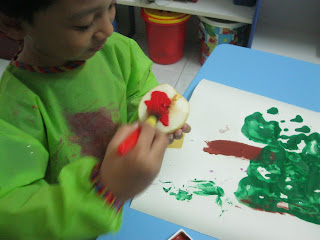Parents, teachers, siblings, and even other children all help the young children learn about the world. Vygotsky introduced a term that is very popular today : the zone of proximal development, or the ZPD, for short. He recognized that there is a range, or zone, of tasks that the child cannot yet handle alone but can accomplish with the help of more skilled partners. And this, of course, is where parents and caregivers come in. Consider the following scenario.
Three year old Matthew is on a rug in the kitchen working on a puzzle. But he is getting very frustrated. He just can't get the wooden pieces to slide in easily. Usually he's very good at puzzles, but he refused to have a nap today and is a bit short on patience. His mother, making dinner, watches him for a bit out of the corner of her eye, and when she thinks he's tried on his own long enough, she sits down on the rug with him. Without saying a word, she turns the puzzle frame in a way that matches his puzzle piece. Voila! He gets the piece in and she says, "Wow, Matthew, you are really good at these puzzles!" They go through this little routine seven or eight more times until the puzzle is complete. Matthew looks very pleased with himself and goes on to something else, as does his mother.
The ZPD might be translated as the "zone of near development", development just outside one's own expertise when working alone. The ZPD captures the difference between what we can do alone and what we can do someone's help. What Matthew could do alone was one thing. But what Matthew could do with a little help was something else again... Vygotsky argued that this is just how cognitive development works : Children develop the leading edge of their competence in interactions with others. We can help children to go that extra step, to progress just a little bit beyond where they are today. How do we do this? Another world-renowned psychologist gave it a name : scaffolding. Professor Jerome Bruner of New York University said that this concept of scaffolding invites parents to be participants in rather than spectators of their children's development.
Discovering Hidden Skill : Scaffolding
This time, you're going to observe a "hidden skill" that adults, rather than children' possess. Because it may difficult to interact with your child and watch yourself in a detached, scientific way at the same time, ask another parent or adult to interact with your child as you observe. You are watching for ways in which the adult scaffolds a task for your child. Ideally, your child should be 3 years old or less. Have the adult give your child a new toy - something that requires manipulation and is a bit beyond your child's skill level. Sit back and observe the ZPD in action as the other adult goes out of her way to make the play session a success for your child. Watch how the adult manipulates the object and sets up the situation so that your child can do things with the toy. We might call these "motor hints" - things that adult does to help your child use her body to make the toy work. These include things like re-positioning the toy, shaping a child's hand, pushing something closer to the child, holding the toy so that it's easier to manipulate for little hands and so on. Also watch for "language hints" - things the adult says to tip off the child about what to try to make the toy work. Watch for encouragement and exhortions, things like "That's right! You can do it! Press a little harder." All of these adult behaviors constitute scaffolding. Adults go out of their way to make children feel and look smart by helping them (a bit) to complete the tasks that children set for themselves.
It's important to note that the ZPD works best when it is the child, not the adult, who decides what "work" need to be done. The parent or caregiver needs to follow the child's lead, letting the child determine which particular goal she wishes to fulfill. Parents are often amazed at how long their young child's attention span can be. The circumstances when this occurs are exactly those times when the child is pushing to get something done, not just following the adult's lead.













